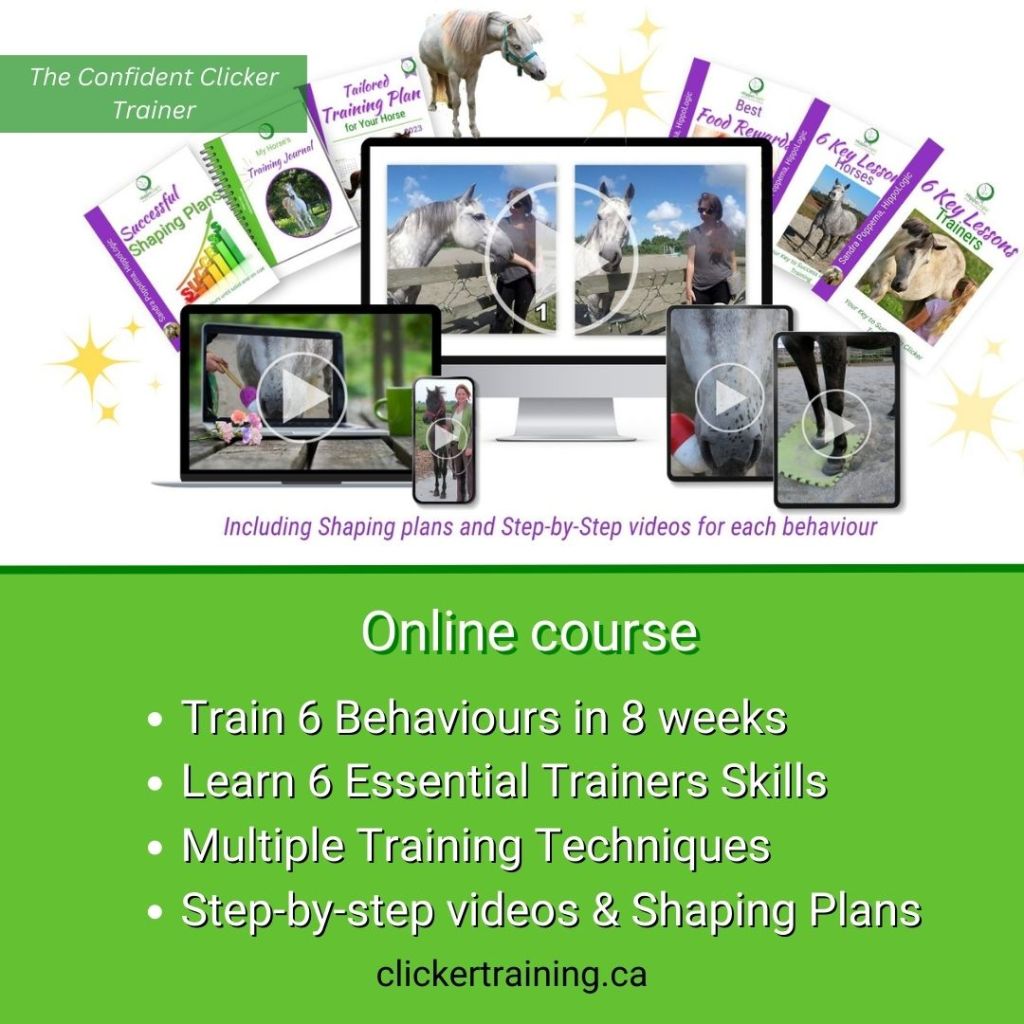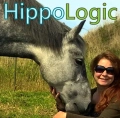One of the key lessons I like to promote as a really good foundation to start with and to keep working on, is safe behaviour around food, ‘table manners for horses’ so to say.
Why is this one of the ‘key lessons’?
If you are working with horses you always want to be as safe as possible. You certainly don’t want to create problems, which can easily happen if you train with food as a reinforcer without having clear ‘rules’. Rules are alle about expectations:
- When can your horse expect a treat: only after a click
- When can’t he expect treats: no click,
no glory, no treat - How he can earn clicks that lead to treats: paying attention to the cue and answer the question right
Your Key to Success in using food as reinforcer is to teach your horse safe hand-feeding or Key Lesson Table Manners. Key Lessons are your Key to Success in Clicker Training your Horse.

Ground rules in clicker training
People who, in the horses’ eyes, reward randomly with food will have horses that are always expecting the unexpected: a random treat. That leads to impatient horses: they want it now!
Therefor you have to start making clear your horse has to know he has to do something in order to get a reward. He also has to know what it is he did, that made him earn the treat. He has to learn to pay attention to your marker (the click). No click, no (food) reward.
Mugging
What to do if your horse is mugging you? Using a marker makes it easier for your horse to understand that ‘mugging’ is never reinforced. There is no click, so no food will come his way.
Mugging is annoying for the handler and can trigger frustration in the horse. Especially if he sometimes gets rewarded for this behaviour (with attention, a pet or even food) while other sometimes he gets punished for it or ignored. It is this various ‘reward’schedule that strengthen this undesired behaviour even more. How to handle this?
You want to reinforce the opposite behaviour of mugging. A behaviour that is incompatible with pushing your arm or sniffing your pockets. This will make your training sessions more safe.
Table-Manners for Horses
- Teach your horse to move his head (read: mouth) away from you, your pocket with food or your ‘money belt’ full of goodies.
- Teach your horse to keep his lips closed
- Teach him to gently take the treat off of your hands
- Teach him an ‘End-of-Session’ signal that means: no more clicks, no more treats
Table manners around dinner time
If you want your horse to behave around feeding time, you have to communicate clearly what behaviour you expect from him:
- standing with four feet on the floor while the food cart is coming
- back up when the stall door is opened or when the hay is delivered and so on.
Use a marker signal to pinpoint the wanted behaviours. Read more here.
Teach your horse ‘Polite’ behaviours
With ‘polite’ behaviour I mean safe behaviour. The horse must wait ‘politely’ until the food is delivered to his lips, after the marker. He shouldn’t move towards the treat, he has to learn that the treat will come to him. The horse must (learn to) take the treat carefully off of my hand and only use his lips and no teeth.
When I click and when I deliver the food, I pay close attention to the horses state of mind. Those two moments (click and the delivery of the treat) are the reinforcing moments, and I do want to reinforce safe behaviour, so I pay attention to the horses state of mind.

You are the Trainer
Present the food in a safe way to the horse and ‘prove’ to your horse that you are trustworthy. You will always deliver a food reward after a click and you will deliver it (bring it to his mouth so he won’t have to ‘search’ for it). If you drop it on the ground, simply give another one.
People who are easily scared by a horse that moves towards the treat in their hand and proceed to drop the food, need to work on their food presenting skills. You want the horse to trust you on where the food is presented (to their mouth) and that it will arrive. Be consistent and reliable in the way you present treats.
Before you click, always check if you still have at least one more treat to offer. It doesn’t have to be food, but if you’re working with food, make sure you have something left in your pocket to give.
Value of your Treat (Appetitive)

The value of the reward, the size and the chewiness can all influence (un)desired behaviours around food. If the size of the treat is too small, it can easily fall on the floor and get lost, if it is too big it can be hard to eat quickly. Is the reward a high value treat, the horse get frustrated if it’s not delivered quickly enough. If the horse has to chew very long it can distract him from the training.
There are many aspects to take into consideration when you reinforce your horse with food. Please don’t let this long list scare you away from working with food rewards.
Food is such a powerful reinforcer that once your horse understands how you want him to behave around food and treats in training, you can have a lot of fun with it!
Links to other key lessons
- Horse, stay in training mode: equine emotions during training
- targeting
- head lowering & backing
- mat training
- ‘patience’
If you think this is a blog that someone can benefit from, please use one of the share buttons below. Or post your comment/question, I read them all! Or simply hit the like button so I know you appreciated this blog. Thank you!
Do you struggle with a horse that mugs you for treats or attention?
Do you wish your horse would behave better but you want can use some help?
Maybe your horse:
- Paws for attention when he’s at the grooming place
- Kicks his stall doors
- Always is ‘in your pocket’ (and most often you wish he wasn’t like that)
- Becomes pushy (or nibbles) when you have treats in your pockets
- His mugging behaviours are holding you back from clicker training awesome, amazing or useful and safe behaviors
If you would like to learn where in your training you can improve so that you would get the results you want in clicker training, grap this opportunity to get a free Clicker Training Assessment!
After your assessment you know exactly what to improve and how you can avoid the pitfalls that keeps you stuck. You’ll know your next step and you’ll walk away with valuable insights about your training style.
More blogs about Mugging and how to re-train it
Sandra Poppema, B.Sc.
I help horse owners get the results in training they really, really want with joy and easy for both horse and human. I always aim for win-win in training in order to enhance the bond between horses and humans!
Become a Confident Clicker Trainer
When you want to do more with positive reinforcement and feel confident training your own horse, this is the course for you!
The Confident Clicker Trainer course is a high quality, online training program that you can do yourself. You’ll become automatically confident in your skills when you get predictable results. This course is aimed at novice and advanced clicker trainers who want to make their foundation really, really strong so that they can train everything else you want, faster and easier.

Enjoy Your Horse More
When you implement more positive reinforcement in your training and daily interactions with your horse, you ‘ll develop a strong bond. You’ll enhance the communication and built mutual trust and understanding. Clicker Training is so much more than a training method!





Goede post, zie wel erg vaak dat paarden die met eten beloond worden erg opdringerig worden en dat eigenaren dit vaak accepteren.
LikeLike
Dat is het: de eigenaar moedigt dit gedrag (onbedoeld) aan. Vooral paarden die erg enthousiast worden van het vooritzicht van voerbeloningen kun je goef ‘tafelmanieren’ bijbrengen. Ze willen alles immers wel doen voor een beetje lekkers. De trainer moet zich er alleen wel ven bewust zijn, zoals je al zei.
LikeLike
Very good tips indeed! I have always taught the horses I look after that they have to take a step back first, before they get a snack. The same goes for dinner, they have to wait until I give them permission to step forward to their food.
LikeLiked by 2 people
Safe rule, I like it
LikeLike
Pingback: Horse, stay in learning mode | Hippologic's Horse Training
Pingback: Key lessons: head lowering & backing | Hippologic's Horse Training
Pingback: Key lesson: targeting | Hippologic's Horse Training
Pingback: Key lesson: mat training | Hippologic's Horse Training
Pingback: Time saving barn hacks | HippoLogic
Pingback: Myth Monday: Training with Food reward causes pushy Horses | HippoLogic
Iedereen die voedsel wel gebruiken als beloning zou dit eerst moeten lezen. Te veel mensen doen maar wat raak. Mooi en duidelijk geschreven.
LikeLiked by 1 person
Dank je, Jensvl. Als je wilt dat meer mensen dit zouden moeten lezen, voel je vrij om dit artikel te delen of te linken op je sociale media. 🙂
LikeLike
Pingback: Sleutel tot Succes: Leer je paard Etiquette (veilig gedrag rondom voer) – HippoLogic's Nederlandse blog
Pingback: This is how I plan my Equestrian Year for 2018 | HippoLogic
Pingback: Smart strategy to train a halter shy horse | HippoLogic
Pingback: Clicker Training 101: Your first clicker session (including a step-by-step training plan) | HippoLogic
Pingback: 6 Things You Might Not Know About Clicker Training (4/6) | HippoLogic
Pingback: 3 Reasons to Use Treats in Training | HippoLogic
Pingback: How to Teach Your Horse to do Crunches with 100% R+ | HippoLogic
Pingback: 6 Steps to Start Riding with Positive Reinforcement (1/6) | HippoLogic
Pingback: Horse, Stop Mugging Me! | HippoLogic Horse Training
Pingback: Key Lesson: 'Patience' - Equine Clicker Training
Pingback: Key lesson: targeting - HippoLogic Horse Training
Pingback: 6 Steps to Start Riding with Positive Reinforcement (1/6) - HippoLogic Horse Training
Pingback: Key lesson: Horse, stay in learning mode [emotions in training] – HippoLogic Horse Training
Pingback: Clickertraining Rita, het onbenaderbare muildier – HippoLogic: Hippo=paard, Logic = Wetenschap
Pingback: What to do if your horse is mugging you | HippoLogic -> Clickertraining.ca